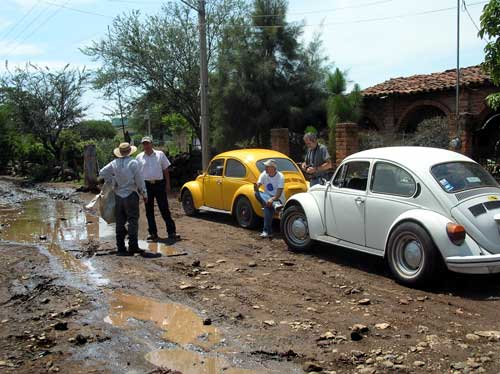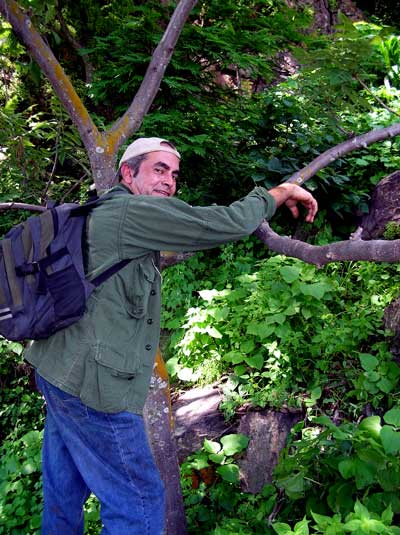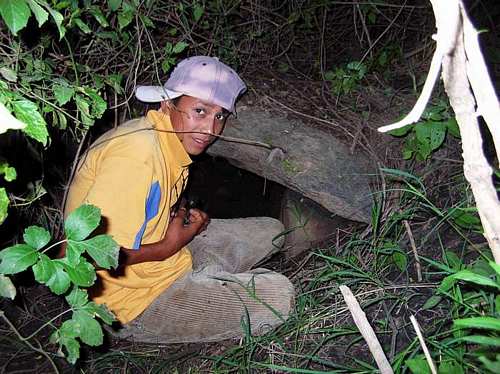Another Zotz Speleo Mythbuster
THE DEMYTHIFICATION OF EL PICACHO CAVE
“That cave goes right through the mountain, she does, all the way to the other
side and thar’s GOLD inside her, te lo juro, more gold than you could ever
imagine!”
It was the first week of August, 2007. Luis Rojas and I were standing in a muddy
street in the village of Chapulimita, just north of Ahualulco, surrounded by a
crowd of men and boys who were briefing us on La Cueva del Picacho, located
somewhere nearby...
Downtown Chapulimita. Our all-terrain VW Bug
(the white one) was raring to go, but ended up parked here all day.
|
 |
...“Hay un espanto (There’s a ghost) guarding that cave…” explained an old-timer
who turned out to be our guide, “…and as soon as you get good and deep inside it
and finally come to the gold, the espanto blows out your flashlight (!) and you
hear an unearthly voice saying TODO O NADA (All or Nothing)…”
“Which is why we need a lot of people, so we can carry out all the gold at
once,” chimed in a wiry youngster who looked like he’d make a great caver.
Then our guide pointed at our car. “That little Bug will never make it, not even
with those big tires,” he said. “The road is slippery.”
Fortunately, it seemed like everyone in Chapulimita was interested in visiting
Picacho Cave and a tall, lanky fellow wearing a camouflage shirt immediately
volunteered his truck.
Our main problem solved, we were invited onto the gangly soldier’s porch for
cool drinks. From the side of the house we could hear “Are you sure the tank’s
not empty?” and after a little while a big red pickup truck backed out onto the
street. Then we and what seemed half the
town were scrambling into the pickup’s open bed. Luis and I got the seats of
honor on top of a built-in metal box. We soon found out these seats positioned
us so we were the first to get hit by every tree overhanging the road...
| ...Once the back of the truck was stuffed with as many
bodies as could fit, we rumbled onto the road. Behind us came a skinny, spotted
dog, running at top speed. It leapt into the air and landed right in the truck
bed on top of the enthusiastic cave hunters. Numerous hands immediately grabbed
the dog, lifted it high above their heads and unceremoniously heaved it back
onto the road. By now the truck had gathered considerable speed, but that dog no
sooner hit the ground than it was galloping behind us and gaining on the truck.
Then another mighty leap and Spot the Wonder Dog landed in our midst again, feet
flying. Naturally, two seconds later the dog was flying in the opposite
direction again. You won’t believe it, but this scene was re-enacted yet a third
time before Spot finally gave up and joined two other dogs which followed us the
entire way. Spot
the dog wagging tail just before being thrown off the truck. |
 |
| ...We could soon understand why Spot preferred riding in the truck. He knew what
was coming up ahead. That road was not just “slippery,” it soon turned into a
regular river and the few “dry” stretches had deep, thick mud sticky enough to
trap an elephant. It was obvious our soldier friend had driven this road a
million times. He knew exactly when to speed up, when to slow down and which
side of the river had the least potholes hidden underneath.
While watching our driver’s skillful maneuvers through the murky waters, we had
to keep a sharp watch for plants and branches: WHAP! “That was a close one, did
you see those thorns?” SKREECH! “Look out for those agaves—the Aztecs used to
use their sharp points as sewing needles!” ARGHH! “Be careful, the sugar cane
leaves are like razor blades and can cut you to ribbons!”
Luis Rojas
inspects the so-called road.
|
 |
After eight kilometers (which seemed more like 80) of lurching and splashing,
the truck came to a stop at the edge of a big agave field. Our guide pointed
vaguely over the top of a dense tangle of trees and brush: “It’s that-a-way!”
And into the maleza we plunged. The first thing we came to was a stream full of
chocolate-colored water and—of course—plenty of mud. “Follow the stream!”
shouted our guide and we slipped and slid over smooth, wet rocks until we
eventually left the stream and headed into a forest of huizache bushes. These,
of course, are acacia trees, famous for their sharp thorns. “Ah, so it’s going
to be one of those kind of cave hunts,” I said to myself as I stashed the camera
and pulled on my heavy-duty gloves. Sure enough, no sooner had we cleared the
huizaches than we found ourselves in a dominguilla patch. “We call this plant
“El Quemador” (the One that Burns),” our friend told us and I soon saw a lot of
red arms and painful looks because that was no “patch,” it was a regular
Dominguilla Jungle and it took forever for us to get out of it.
| ...But suddenly,
high above us loomed the rocky peak of El Picacho. “There it
is!” said the guide. “See? You can make out the cave entrance from here.”
“Uh-huh,” mumbled Luis Rojas who was already studying it with his monocular. “I
can make it out alright and that cave is only four meters deep. In fact, I can
see the end of it from here.”
“Oh no, no! You are totally mistaken,” everyone shouted. “We know all about that
cave. It goes all the way through the mountain, not to mention the fabulous…”
El Picacho within
view...so near and yet so far...
|
 |
|
"OK, OK," we said and we all plunged back into the "jungle."
Bravely, we forged ahead, but, unable to see anything, we had
no idea whether we were heading in the right direction, and, it seemed,
neither did our "guide."
Finally we stopped for a breather. “Amigos,"
we said, "it’s now 3:30 PM and there’s nothing but thick maleza
(weeds, thorns and worse) ahead of us …why don’t we come back in the dry season?"
Well, this was debated a while and it looked like most of the gang were ready to
throw in the towel, when suddenly from the tangled brush ahead of us, we heard a
kid’s voice: “Vengan, Vengan, I found a clear spot.”
Reconsidering
strategies in the "jungle"
|
 |
|
“Vámonos!" Shouted the whole crowd and off we went. Half an hour later, we were
at the foot of El Picacho, working our way up enormous blocks of volcanic rock.
|
 |
|
Halfway up the mountain, we came to a nicely shaded spot with a tremendous view
of the surrounding countryside. The cave was now about 50 meters above us. But
it looked pretty much straight up to me.
“I’m no mountain-climber,” I said. “Go to it, Luis…”
Luis Rojas,
already dripping with sweat, prepares to climb up the sheer cliff to
fabulous El Picacho Cave.
|
 |
Followed by four humans and one dog (Spot, of course), Luis crept up the sheer
wall, peeked into the cave and shouted, “Four meters!” down to the rest of us.
Then he turned and took a look at the face of the soldier, who was right behind
him.
“His pupils were dilated and I knew he had gone into shock,” Luis told us later.
“Apparently he had made the mistake of looking down (a 150 meter drop). Since he
was a soldier, I started giving him short, concise orders: turn around! Grab the
rock! Don’t move! etc. Then I got out my fetucha (flat nylon webbing) and tied
all of us but the dog together.”
| How Spot made it up
that vertical wall to the cave entrance, I don’t know. How he made it back down
is even more amazing, especially in the light of the terrified yelps of the
other two dogs when they tried to head back down from the sheltered balcony
where the rest of us had taken refuge.
Mountain-climbing Spot, racing down the
hillside.
|
 |
|
The Chapulimita
Caving Club, perched upon the only flat spot on the mountainside,
celebrating the successful discovery and exploration (lasting three seconds
max) of El Picacho Cave. The number one topic of discussion was the
word "vertigo" which the soldier (slightly woozy guy in middle) had never
heard of until this particular day.
|
 |
Well, there was just enough daylight for us to make our way through the
poisonous
plants, acacia forest and muddy stream, hop back into the truck, dodge the thorns, agave spikes and slashing cane leaves and splash through the deep waters and
muddy ruts back to the soldier’s home, where we were rewarded with a delicious
supper of home-made tostadas. The big talk all through the meal was the
hard-to-swallow discovery that El Picacho Cave was not, after all, the marvel
that everyone in town had always believed in. "A legend has died today!"
said one of the boys and I think that summed it up quite nicely.
It was now 7:30 PM. “Thanks for everything,” we said, eyeing the sky which was
filling with black clouds.
“No, no!” piped up one of the kids. “There’s one more cave you have to see. It’s
right here in the pueblo.” Luis and I looked at each other.
“Bueno,” said Luis, “as long as it’s right here, let’s take a quick look.”
| There is probably no need to describe what happened next: you can
surely
guess where "right here" turned out to be. Weaving through practically every
empty lot in Chapulimita, our young guide led us right out of town until we were once again
ducking under acacia branches, hopping over muddy puddles and carefully dodging
steaming cow pies. As thunder ominously rumbled in the distance, we arrived at
the “cave.”
“It’s a drain pipe,” I said.
“No, no, it’s a cave,” cried our budding spelunker. “Just look inside.”
The grand
entrance to Drain Pipe Cave. |
 |
I got down on my belly, shined my light inside the hole and looked. “1.5
meters,” I announced, “and plenty of mud.” The little boy got down there with me
and seemed utterly amazed that there was no entrance to Cacahuamilpa Caverns
inside his drain pipe.
At last we could take our leave of Chapulimita, its imaginative citizens and its
miserable caves. As we climbed into our Bug, a crowd surrounded us. “We know
another cave, right next to a wonderful waterfall,” they shouted above the
howling wind. “We’ll be waiting for you next week.”
Now, darkness fell and with it came the biggest thunderstorm we had seen in
years. As the deluge poured over us and lightning bolts cracked above us, we
unanimously decided that we would leave Wonderful Waterfall Cave for Susy and
Sonia. “It’s only fair,” we agreed, “We wouldn’t want to deprive them of the
Chapulimita experience.”
John Pint
The Hero of our story: Spot the Wonder Dog
Back to
the Mexico Page










